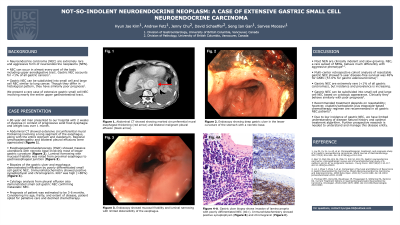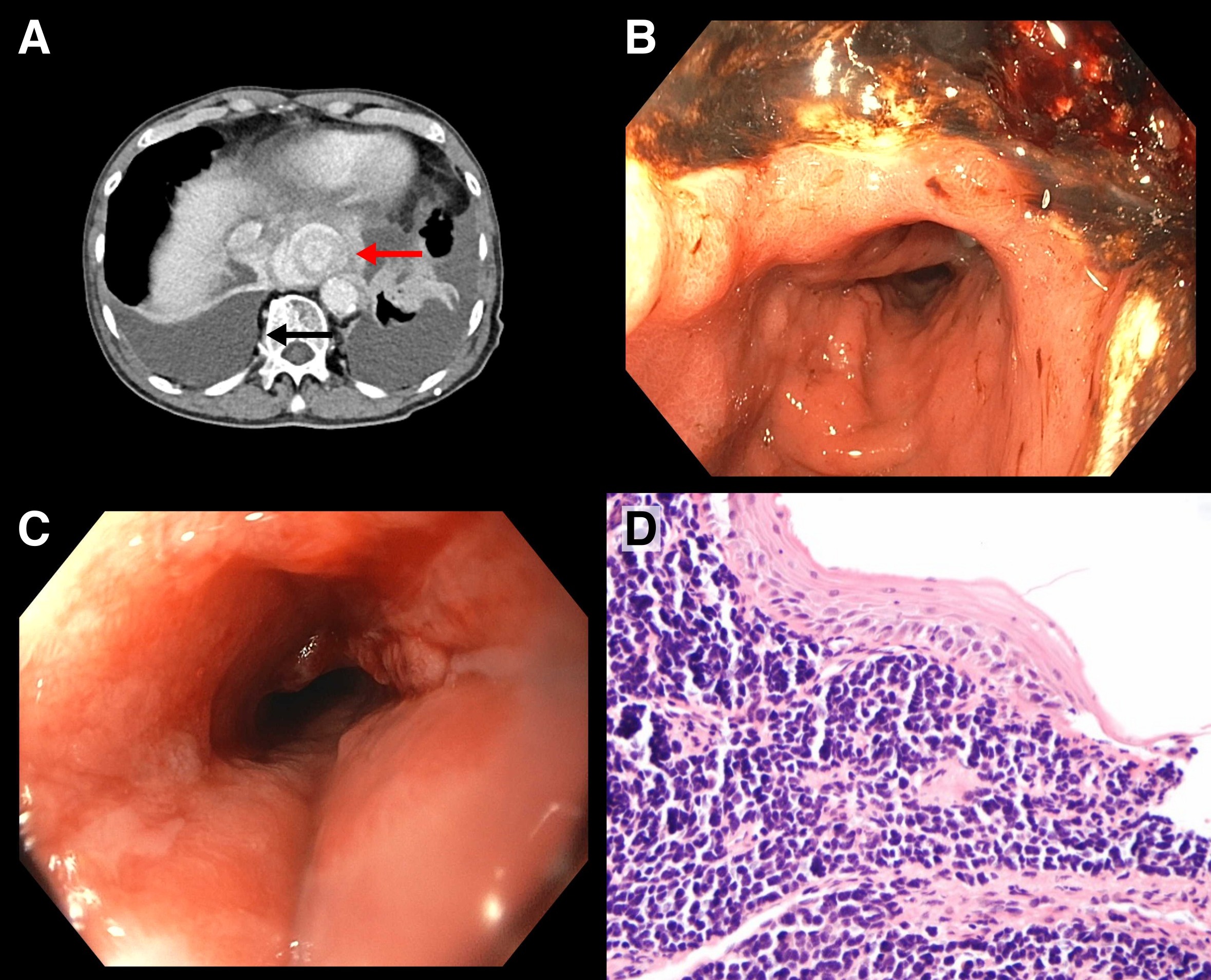Tuesday Poster Session
Category: Stomach
P4234 - Not-So-Indolent Neuroendocrine Neoplasm: A Case of Extensive Gastric Small Cell Neuroendocrine Carcinoma
Tuesday, October 24, 2023
10:30 AM - 4:00 PM PT
Location: Exhibit Hall

Has Audio
- HK
Hyun Jae Kim, MD
University of British Columbia
Vancouver, BC, Canada
Presenting Author(s)
Hyun Jae Kim, MD1, Andrew Fetz, MD1, Seng Ian Gan, BSc, MD, FRCPC2, Sarvee Moosavi, BSc, MD, FRCPC2
1University of British Columbia, Vancouver, BC, Canada; 2University of British Columbia, Vancouver General Hospital, Vancouver, BC, Canada
Introduction: Neuroendocrine neoplasms (NENs) are uncommon but can occur in almost every site in the body including lung, intestine, stomach, and pancreas. The majority of gastrointestinal NENs are well-differentiated and follow an indolent course. On the other hand, neuroendocrine carcinomas (NECs) are an extremely rare and aggressive form of NEN that have a poor prognosis. In this report, we present a rare case of gastric small cell NEC, a subtype of gastric NEC, involving nearly the entire upper gastrointestinal tract.
Case Description/Methods: An 80-year-old man presented to a tertiary hospital with two weeks of dyspnea, along with progressive solid food dysphagia and weight loss over one month. Abdominal CT scan demonstrated extensive circumferential mural thickening involving a long segment of the esophagus, along with the entire stomach and duodenum, accompanied by regional lymphadenopathy and bilateral pleural effusion (Figure A). Esophagogastroduodenoscopy showed massive ulcerations with necrotic base involving most of the lesser curvature of gastric body (Figure B). In addition, luminal narrowing with mucosal friability was noted from proximal esophagus to gastroesophageal junction for 20 cm (Figure C). Biopsies of the gastric ulcer and esophagus demonstrated infiltration by poorly differentiated cells positive for synaptophysin and chromogranin on immunohistochemistry, suggestive of small cell NEC with Ki67 over 80% (Figure D). Thoracentesis of pleural effusion also demonstrated small cell NEC and confirmed metastatic disease. The prognosis was estimated to be 3-6 months. Considering his age, frailty, and extent of disease, the patient and his family opted to avoid systemic chemotherapy, awaiting transfer to hospice care.
Discussion: Gastric small cell NEC is an extremely rare, but aggressive malignancy, accounting for less than 1% of all gastric carcinomas. Unlike the more common and indolent well-differentiated forms of gastric NENs, gastric small cell NEC exhibits deep invasion and early metastasis, resulting in poor prognosis. Due to the rarity of this condition and our limited understanding of these tumors, there is limited literature on standardized treatment. Our case highlights the aggressive nature of gastric small cell NEC, while presenting relatively acutely, the disease had already manifested extensively with metastasis. Hereby, we aim to raise awareness and encourage further research in the management of this rare, yet aggressive neoplasm.

Disclosures:
Hyun Jae Kim, MD1, Andrew Fetz, MD1, Seng Ian Gan, BSc, MD, FRCPC2, Sarvee Moosavi, BSc, MD, FRCPC2. P4234 - Not-So-Indolent Neuroendocrine Neoplasm: A Case of Extensive Gastric Small Cell Neuroendocrine Carcinoma, ACG 2023 Annual Scientific Meeting Abstracts. Vancouver, BC, Canada: American College of Gastroenterology.
1University of British Columbia, Vancouver, BC, Canada; 2University of British Columbia, Vancouver General Hospital, Vancouver, BC, Canada
Introduction: Neuroendocrine neoplasms (NENs) are uncommon but can occur in almost every site in the body including lung, intestine, stomach, and pancreas. The majority of gastrointestinal NENs are well-differentiated and follow an indolent course. On the other hand, neuroendocrine carcinomas (NECs) are an extremely rare and aggressive form of NEN that have a poor prognosis. In this report, we present a rare case of gastric small cell NEC, a subtype of gastric NEC, involving nearly the entire upper gastrointestinal tract.
Case Description/Methods: An 80-year-old man presented to a tertiary hospital with two weeks of dyspnea, along with progressive solid food dysphagia and weight loss over one month. Abdominal CT scan demonstrated extensive circumferential mural thickening involving a long segment of the esophagus, along with the entire stomach and duodenum, accompanied by regional lymphadenopathy and bilateral pleural effusion (Figure A). Esophagogastroduodenoscopy showed massive ulcerations with necrotic base involving most of the lesser curvature of gastric body (Figure B). In addition, luminal narrowing with mucosal friability was noted from proximal esophagus to gastroesophageal junction for 20 cm (Figure C). Biopsies of the gastric ulcer and esophagus demonstrated infiltration by poorly differentiated cells positive for synaptophysin and chromogranin on immunohistochemistry, suggestive of small cell NEC with Ki67 over 80% (Figure D). Thoracentesis of pleural effusion also demonstrated small cell NEC and confirmed metastatic disease. The prognosis was estimated to be 3-6 months. Considering his age, frailty, and extent of disease, the patient and his family opted to avoid systemic chemotherapy, awaiting transfer to hospice care.
Discussion: Gastric small cell NEC is an extremely rare, but aggressive malignancy, accounting for less than 1% of all gastric carcinomas. Unlike the more common and indolent well-differentiated forms of gastric NENs, gastric small cell NEC exhibits deep invasion and early metastasis, resulting in poor prognosis. Due to the rarity of this condition and our limited understanding of these tumors, there is limited literature on standardized treatment. Our case highlights the aggressive nature of gastric small cell NEC, while presenting relatively acutely, the disease had already manifested extensively with metastasis. Hereby, we aim to raise awareness and encourage further research in the management of this rare, yet aggressive neoplasm.

Figure: Figure A – CT scan showing marked circumferential mural thickening involving the esophagus (red arrow) and malignant pleural effusions (black arrow). Figure B – Deep gastric ulcer in the lesser curvature with necrotic base. Figure C – Luminal narrowing of esophagus, despite insufflation, with mucosal friability. Figure D – H&E of gastric ulcer biopsy showing invasion of lamina propria with poorly differentiated hyperchromatic cells with minimal cytoplasm (40×).
Disclosures:
Hyun Jae Kim indicated no relevant financial relationships.
Andrew Fetz indicated no relevant financial relationships.
Seng Ian Gan: Boston Scientific – Consultant.
Sarvee Moosavi: Bausch Health – Advisory Committee/Board Member, Speakers Bureau. Knight Therapeutics – Advisory Committee/Board Member, Speakers Bureau. Medtronic – Advisory Committee/Board Member, Speakers Bureau.
Hyun Jae Kim, MD1, Andrew Fetz, MD1, Seng Ian Gan, BSc, MD, FRCPC2, Sarvee Moosavi, BSc, MD, FRCPC2. P4234 - Not-So-Indolent Neuroendocrine Neoplasm: A Case of Extensive Gastric Small Cell Neuroendocrine Carcinoma, ACG 2023 Annual Scientific Meeting Abstracts. Vancouver, BC, Canada: American College of Gastroenterology.
